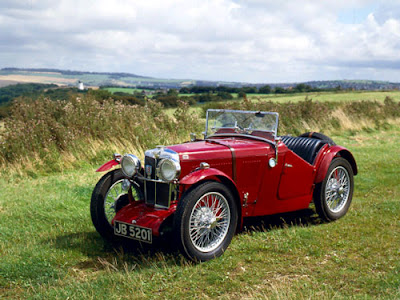MG TF 160
MG J-type Midget
MG TF 160
MG J-type Midget
The MG J-type was produced by the MG Car company from 1932 to 1934. This 2 door sports car used an updated version of the overhead camshaft, crossflow engine, used in the 1928 Morris Minor and Wolseley 10 and previously fitted in the MG M-type Midget of 1929 to 1932, driving the rear wheels through a four speed non-synchromesh gearbox. The chassis was from the D-type with suspension by half elliptic springs and Hartford friction shock absorbers all round with rigid front and rear axles. The car had a wheelbase of 86 inches (2184 mm) and a track of 42 inches (1067 mm). Most cars were open two seaters but a closed salonette version of the J1 was also made and some chassis were supplied to external coachbuilders. The open cars can be distinguished from the M-type by having cut away tops to the doors.
There were a few serious failings of the J2, most seriously that it only had a two bearing crank shaft which will break if over-revved. The overhead camshaft drive is by a vertical shaft through bevel gears, a shaft which also forms the armature of the dynamo. Any oil leak from the cambox seal goes into the dynamo brushgear and likely a fire.
Another problem was that it was not fitted with hydraulic brakes, but had Bowden cables to each drum. These require no more pedal force than any other non-power-assisted drum brake, provided that they're well maintained and aren't sloppy or stretchy. The drums themselves are small and even in period it was a common modification to replaced them with larger drums from later models.
The non-syncromesh gearbox takes some getting used to, as for any car of this period, but with its short gear stick it becomes second nature to double de-clutch and rare to grind the gears.
J3
The J3 was a racing version with the engine capacity reduced to 746 cc by shortening the stroke from 83 to 73 mm and fitted with a Powerplus supercharger. The smaller engine capacity was to allow the car to compete in 750 cc class racing events. Larger brakes from the L-type were fitted.
J4
The J4 was a pure racing version with light weight body work and the J3 engine but using more boost from the supercharger to obtain 72 bhp.
Production : 1932-1934 (2494 made)
Predecessor : MG C-type Midget and MG D-type Midget
Successor : MG P-type Midget
Class : Sports Car
Body style(s) : 2-door roadster (Salonette)
Engine(s) : 847 cc Straight-4
Engine(s) : 847 cc Straight-4
Engine(s) : 746 cc Straight-4
Engine(s) : 746 cc Straight-4
J1
The J1 was the four seat car in the range. The engine was the 847 cc unit previously seen in the C-type with twin SU carburetors giving 36 bhp. The car cost £220 in open and £225 in Salonette form.J2
The J2 was the commonest car in the range and was a road going 2 seater. Early cars had cycle wings but these were replaced in 1933 by the full length type that was typical of all sports MGs up to the 1950's TF. The top speed of a standard car was 65 mph but a specially prepared one tested by The Autocar magazine reached 82 mph. The car cost £199.There were a few serious failings of the J2, most seriously that it only had a two bearing crank shaft which will break if over-revved. The overhead camshaft drive is by a vertical shaft through bevel gears, a shaft which also forms the armature of the dynamo. Any oil leak from the cambox seal goes into the dynamo brushgear and likely a fire.
Another problem was that it was not fitted with hydraulic brakes, but had Bowden cables to each drum. These require no more pedal force than any other non-power-assisted drum brake, provided that they're well maintained and aren't sloppy or stretchy. The drums themselves are small and even in period it was a common modification to replaced them with larger drums from later models.
The non-syncromesh gearbox takes some getting used to, as for any car of this period, but with its short gear stick it becomes second nature to double de-clutch and rare to grind the gears.
J3
The J3 was a racing version with the engine capacity reduced to 746 cc by shortening the stroke from 83 to 73 mm and fitted with a Powerplus supercharger. The smaller engine capacity was to allow the car to compete in 750 cc class racing events. Larger brakes from the L-type were fitted.
J4
The J4 was a pure racing version with light weight body work and the J3 engine but using more boost from the supercharger to obtain 72 bhp.
MG J-type Midget
Manufacturer MG Car CompanyProduction : 1932-1934 (2494 made)
Predecessor : MG C-type Midget and MG D-type Midget
Successor : MG P-type Midget
Class : Sports Car
Body style(s) : 2-door roadster (Salonette)
MG J1
Production : 1932-1933 (380 made)Engine(s) : 847 cc Straight-4
MG J2
Production : 1932-1934 (2083 made)Engine(s) : 847 cc Straight-4
MG J3
Production : 1932-1933 (22 made)Engine(s) : 746 cc Straight-4
MG J4
Production : 1932-1933 (9 made)Engine(s) : 746 cc Straight-4
Related : MG J-type Midget From Wikipedia, the free encyclopedia, MG TF 160 Cars











 11:25 PM
11:25 PM
 Goohara
Goohara


















0 ความคิดเห็น:
Post a Comment